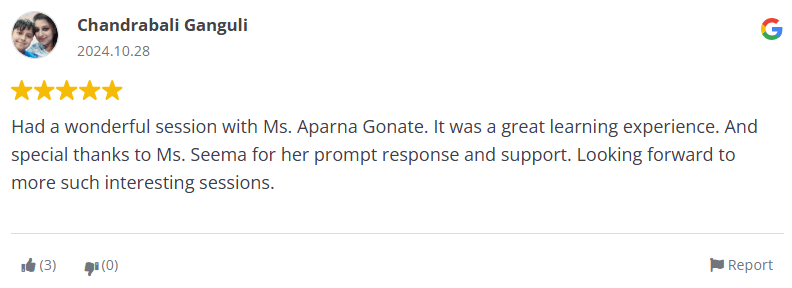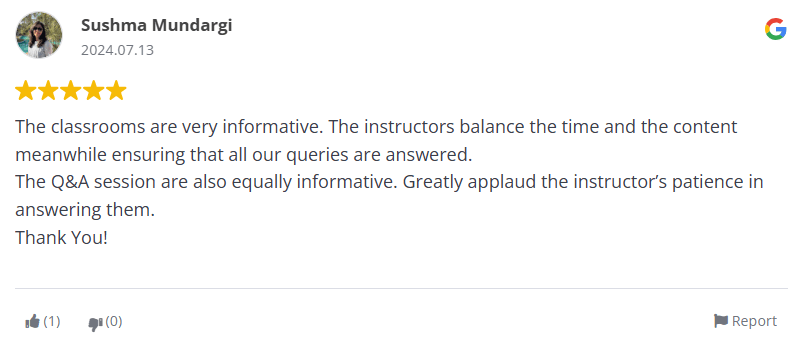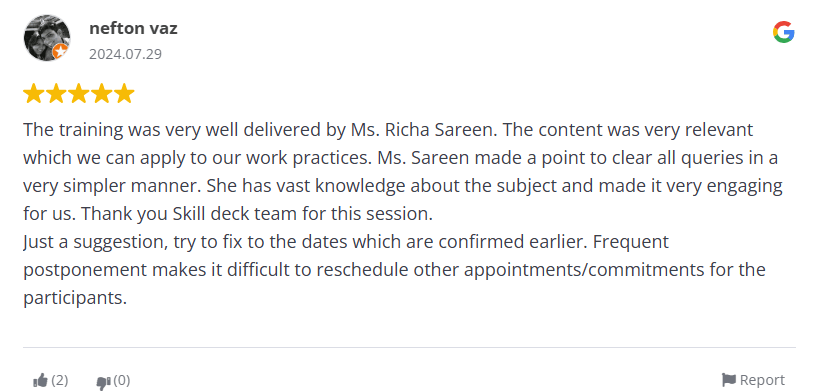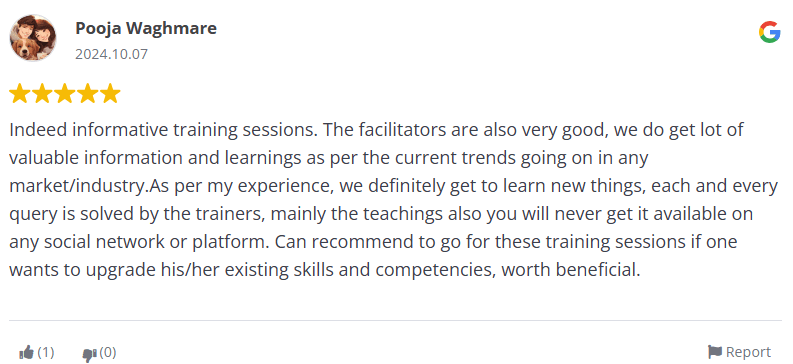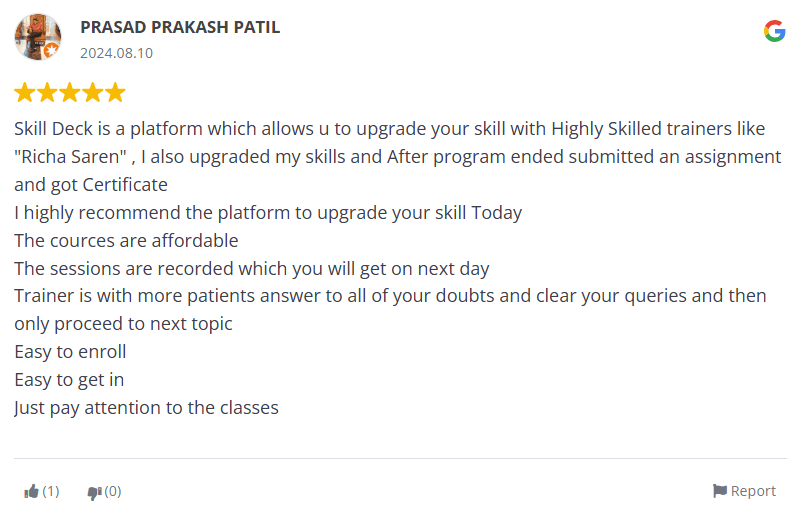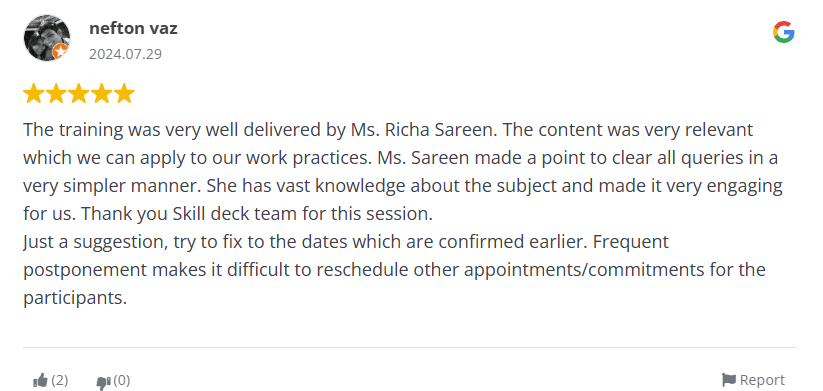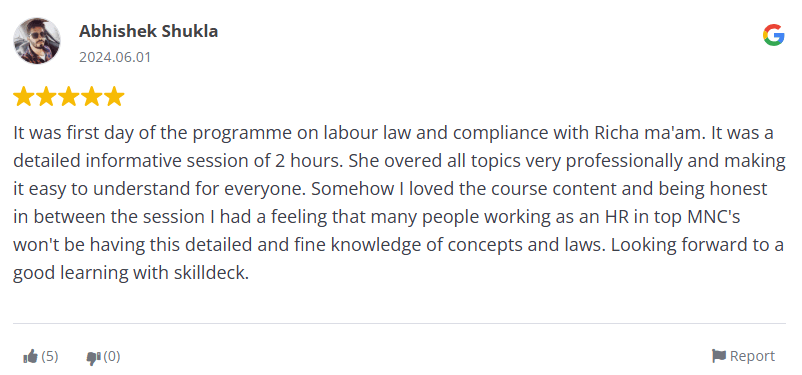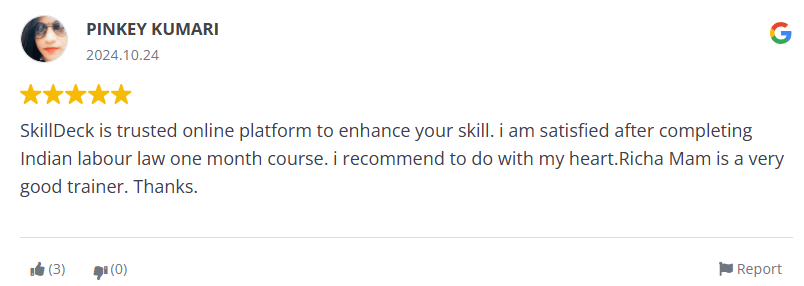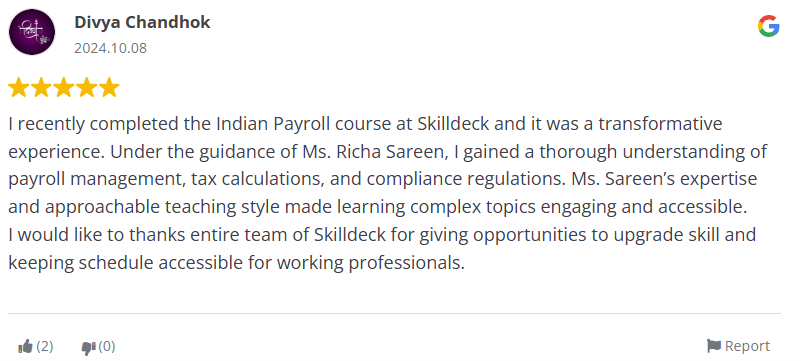- Tenure - 28+ Hours, Live Training
- Upcoming class - 8 Nov 2025 | 7 - 9 PM
- Next Batch - Coming Soon
- Program Fee: 6500 INR
Reserve your seat for Upcoming Batch by filling out the form, 11 Spots Left
HR Essentials Course Online
Who is this program for
For HR’s aiming to become strategic partners

Education
Any graduate
Work Exp.
Min 6 months

Career Stage
Early, Mid or Advance all can do

Aspirations
Achieving higher career growth in HR Essentials and Employee related matters.
Fee & Batch Details
Invest in your future with affordable degree fees and flexible batch options
Program Fee
6,500 INR
No installment plan available for this program
Limited time offer ₹12999
Batch Details
Application Closure : 11 Spots Left
Date for 1st Class: 8 Nov 2025
Seats On First Come- First Serve Basis.
Build your profile with the latest trend and get easily placed in Top Corporates
Our Course Certificates are trusted by these industry leaders




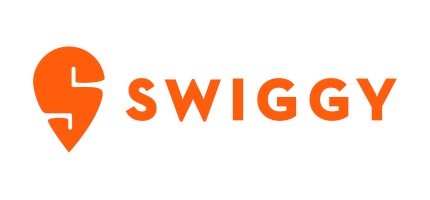





Build Your Resume
Build your profile with the latest trend and get easily placed in Top Corporates
Explore our Syllabus
What you will learn:
- Overview of HR Management
- Definition and importance
- Key functions and responsibilities of HR
- Role of an HR Generalist
- Understanding the HR generalist role
- Skills and competencies required
- HR Department Structure
- Organizational structure of HR departments
- Collaboration with other departments
Module 1: Fundamentals of Talent Acquisition
- What is Talent Acquisition?
- Difference between TA and Recruitment
- Importance of TA in aligning with business strategy
- Manpower Planning: Ratio Trend Analysis
- Workforce Planning: Trends, Forecasting & Demand-Supply Matching
Module 2: Sourcing Strategies & Boolean Mastery
- Recruitment Process Overview (End-to-End)
- Boolean Search Basics
- LinkedIn Boolean Search Techniques
- X-Ray Search Techniques on Platforms like:
- GitHub
- Facebook & other social media
- Chrome Extensions & AI Tools for sourcing
Module 3: LinkedIn Deep Dive & Social Sourcing
- Advanced sourcing
- Passive Candidate Sourcing Techniques
- Social Media Recruitment: Instagram, WhatsApp, Facebook Groups
- Talent Mapping and Market Research
Module 4: AI Tools for Recruitment
- Using ChatGPT for Job Descriptions, Sourcing Queries & Screening Questions
- Overview of AI Tools (Hiretual, ChatGPT, Recruitryte, PromptHackers, etc.)
- Automating Screening & Shortlisting
- Resume Matching & AI-based Evaluation
Module 5: Recruitment Analytics & Metrics
- Key Recruitment Metrics (TAT, Cost per Hire, Quality of Hire)
- Recruitment Dashboards in Excel
- Recruitment Tracker Design in Excel
- Zoho ATS & other ATS tools overview
- Measuring Recruiter Efficiency & Funnel Analytics
Module 6: Competency-Based Recruitment & Evaluation
- Selection Process Design
- Shortlisting Techniques
- Competency Mapping & Behavioral Evaluation
- ADC Exercises for Candidate Evaluation
- Interview Assessment Formats
Module 7: Managing the Recruitment Team
- Giving SMART Targets to the Recruitment Team
Module 8: Final Project + Real-Time Application
- Hands-on Assignments (e.g., sourcing for live roles, designing a JD, recruitment funnel)
- Real-time Boolean search project
- AI-based sourcing demo (live tool usage)
- Recruitment tracker + analytics submission
Employee Engagement and Retention
- Drivers of Employee Engagement
- Job Satisfaction
- Understanding the role of job satisfaction in engagement
- Factors contributing to job satisfaction (work environment, job role, etc.)
- Leadership and Management
- The impact of leadership style on employee engagement
- Best practices for effective management and leadership
- Recognition and Rewards
- Importance of recognizing and rewarding employees
- Different types of recognition programs (monetary, non-monetary)
- Career Development
- Opportunities for growth and development as a driver of engagement
- Creating career development plans for employees
- Work-Life Balance
- The importance of work-life balance in maintaining engagement
- Implementing flexible work arrangements and policies
- Communication and Feedback
- Role of transparent and open communication
- Establishing regular feedback mechanisms
- Job Satisfaction
- Measuring and Improving Engagement
- Employee Engagement Surveys
- Designing and administering surveys to measure engagement
- Key questions to include in engagement surveys
- Focus Groups and Interviews
- Conducting focus groups and interviews to gather qualitative data
- Analyzing responses for actionable insights
- Engagement Metrics and Analytics
- Identifying key metrics to track engagement (e.g., employee NPS, turnover rates)
- Using analytics tools to interpret data and identify trends
- Action Planning
- Developing action plans based on survey results and feedback
- Implementing and tracking improvements
- Continuous Improvement
- Regularly updating engagement strategies based on feedback
- Ensuring ongoing monitoring and adjustment
- Employee Engagement Surveys
- Engagement Models
- The Aon Hewitt Engagement Model
- Engagement Drivers
- Employee value proposition, work environment, rewards and recognition, career opportunities
- Engagement Outcomes
- Say, Stay, Strive model: Employees speak positively about the organization, desire to remain, and put in extra effort
- Engagement Drivers
- The Gallup Q12 Model
- 12 Key Drivers of Engagement
- Includes factors such as having the right materials and equipment, feeling cared for by managers, and opportunities for growth
- 12 Key Drivers of Engagement
- The Zinger Model
- Ten Blocks of Engagement
- Building blocks such as community, meaningful work, and recognition
- Ten Blocks of Engagement
- The Aon Hewitt Engagement Model
- Types of Engagement Activities
- Downward Engagement
- Leadership Communication
- Regular updates from leadership on company goals and performance
- Town hall meetings, newsletters, and executive Q&A sessions
- Feedback Mechanisms
- Surveys, suggestion boxes, and direct feedback channels
- Leadership Communication
- Upward Engagement
- Employee Voice Programs
- Platforms for employees to share ideas and concerns
- Involving employees in decision-making processes
- Mentorship Programs
- Pairing employees with mentors to provide guidance and support
- Employee Voice Programs
- Horizontal Engagement
- Team Building Activities
- Activities that promote teamwork and collaboration
- Social events, team challenges, and group projects
- Cross-Functional Projects
- Encouraging collaboration between different departments
- Projects that require input and cooperation from various teams
- Team Building Activities
- Downward Engagement
- Retention Strategies
- Identifying Retention Risks
- Recognizing early signs of disengagement and turnover risk
- Using data and analytics to identify at-risk employees
- Developing Retention Programs
- Creating targeted retention programs for high-risk groups
- Strategies for increasing loyalty and reducing turnover
- Mentorship and Career Development
- Implementing mentorship programs to support employee growth
- Providing clear career progression paths
- Identifying Retention Risks
- Employee Value Proposition (EVP)
- Creating a Compelling EVP
- Defining the key elements of an EVP
- Aligning the EVP with organizational values and culture
- Communicating and Promoting EVP
- Effectively communicating the EVP to current and prospective employees
- Using EVP in recruitment marketing and employer branding
- Measuring the Impact of EVP
- Assessing the effectiveness of the EVP in attracting and retaining talent
- Continuously refining the EVP based on feedback and results
- Creating a Compelling EVP
Onboarding
Employee Onboarding Process
- Pre-Onboarding Preparation
- Paperwork and Documentation
- Collecting necessary documents (e.g., ID proof, employment contracts, tax forms)
- Setting up employee profiles in HR systems
- Welcome Kit
- Preparing a welcome kit (company handbook, benefits information, company swag)
- Providing necessary equipment and access credentials (e.g., laptop, email accounts)
- Paperwork and Documentation
- Day One Orientation
- Introduction to the Company
- Company history, mission, values, and culture
- Overview of organizational structure and key personnel
- Workplace Tour
- Familiarizing new hires with the office layout, facilities, and amenities
- Meeting the Team
- Introducing new hires to their colleagues and managers
- Conducting team-building activities to facilitate integration
- Introduction to the Company
- Training and Development
- Initial Training Sessions
- Job-specific training and role expectations
- Overview of tools and systems used
- Compliance and Safety Training
- Mandatory compliance training (e.g., data protection, workplace safety)
- Company policies and procedures
- Buddy System
- Assigning a mentor or buddy to new hires for support and guidance
- Regular check-ins and feedback sessions with the buddy
- Initial Training Sessions
- 30-60-90 Day Plan with SMART Goals
- 30-Day Plan
- Orientation and Learning
- Learning about the company, culture, and job responsibilities
- Setting short-term goals for initial learning and adaptation
- SMART Goals
- Specific: Complete all mandatory training sessions
- Measurable: Attend and pass all compliance tests
- Achievable: Schedule one-on-one meetings with team members
- Relevant: Understand the company’s mission and values
- Time-bound: Achieve within the first 30 days
- Orientation and Learning
- 60-Day Plan
- Integration and Contribution
- Beginning to contribute to team projects and meetings
- Developing relationships with colleagues and stakeholders
- SMART Goals
- Specific: Participate in at least two team projects
- Measurable: Contribute to team meetings with actionable ideas
- Achievable: Schedule regular check-ins with the manager
- Relevant: Apply job-specific skills learned during training
- Time-bound: Achieve within the first 60 days
- Integration and Contribution
- 90-Day Plan
- Independence and Performance
- Taking full ownership of job responsibilities
- Demonstrating competence and achieving performance benchmarks
- SMART Goals
- Specific: Complete a major project or task independently
- Measurable: Meet or exceed performance benchmarks
- Achievable: Receive positive feedback from the manager
- Relevant: Contribute to achieving team objectives
- Time-bound: Achieve within the first 90 days
- Independence and Performance
- 30-Day Plan
- Ongoing Support
- Regular Check-ins
- Scheduling regular check-ins with managers and buddies
- Addressing any questions or concerns
- Continuous Feedback
- Providing continuous feedback on performance and progress
- Adjusting goals and expectations as needed
- Regular Check-ins
- Feedback and Evaluation
- Collecting Feedback
- Gathering feedback from new hires on their onboarding experience
- Evaluating Onboarding Effectiveness
- Measuring the success of the onboarding program
- Making improvements based on feedback
- Collecting Feedback
Employee Exit Process
- Resignation and Termination Procedures
- Resignation Process
- Accepting resignations and processing paperwork
- Ensuring a smooth transition for the departing employee
- Termination Process
- Conducting terminations with sensitivity and legality
- Managing the administrative aspects of termination
- Resignation Process
- Exit Interviews
- Conducting Exit Interviews
- Scheduling and conducting exit interviews
- Asking relevant questions to gather meaningful feedback
- Analyzing Feedback
- Identifying patterns and trends in exit interview data
- Using feedback to improve organizational practices
- Conducting Exit Interviews
- Knowledge Transfer
- Ensuring Continuity
- Transferring knowledge and responsibilities to remaining team members
- Documenting key information and processes
- Succession Planning
- Implementing succession plans for critical roles
- Identifying and preparing potential successors
- Ensuring Continuity
- Final Settlements
- Processing Final Pay and Benefits
- Calculating and disbursing final paychecks
- Managing benefits termination and transition
- Returning Company Property
- Collecting company property (e.g., laptops, access cards)
- Ensuring all assets are returned
- Processing Final Pay and Benefits
- Post-Exit Follow-Up
- Maintaining Alumni Relations
- Keeping in touch with former employees
- Leveraging alumni networks for future opportunities
- Maintaining Alumni Relations
Employee Grievance Management
Introduction to Grievance Management
- Definition and Importance
- Understanding what constitutes a grievance
- Importance of effective grievance management
- Types of Grievances
- Common grievances in the workplace (e.g., discrimination, harassment, unfair treatment)
Grievance Management Framework
- Framework Overview
- Steps involved in the grievance management process
- Roles and responsibilities of HR and management
- Establishing a Grievance Policy
- Key components of an effective grievance policy
- Communicating the policy to employees
- Grievance Procedures
- Formal and informal grievance procedures
- Step-by-step process for handling grievances
Grievance Handling Process
- Step 1: Receiving a Grievance
- Methods for lodging a grievance (e.g., written, verbal)
- Initial response and acknowledgment
- Step 2: Investigation
- Conducting a thorough and unbiased investigation
- Collecting and documenting evidence
- Step 3: Resolution
- Evaluating findings and determining appropriate actions
- Communicating the resolution to the involved parties
- Step 4: Follow-Up
- Monitoring the situation post-resolution
- Ensuring no retaliation and checking for ongoing issues
Grievance Handling Committee
- Role and Composition
- Purpose and importance of a grievance handling committee
- Selecting committee members (HR, management, employee representatives)
- Committee Responsibilities
- Reviewing grievances and ensuring fair investigation
- Making recommendations for resolution
- Committee Procedures
- Regular meetings and case review processes
- Ensuring confidentiality and impartiality
Legal Aspects of Grievance Management
- Understanding Employment Laws
- Key employment laws relevant to grievance management (e.g., anti-discrimination laws, labor laws)
- Legal rights and protections for employees
- Compliance and Documentation
- Maintaining proper documentation for legal compliance
- Handling grievances in accordance with legal requirements
- Role of Legal Counsel
- When to involve legal counsel in the grievance process
- Understanding the implications of legal advice and decisions
Best Practices in Grievance Management
- Building a Positive Workplace Culture
- Promoting open communication and trust
- Encouraging early resolution of issues
- Training and Development
- Providing training for managers and HR on handling grievances
- Developing skills for effective conflict resolution
- Continuous Improvement
- Regularly reviewing and updating grievance policies and procedures
- Gathering feedback to improve the grievance management process
Case Studies and Practical Applications
- Analyzing Real-World Scenarios
- Examining case studies of grievance handling
- Lessons learned from successful and unsuccessful grievance resolutions
Module 1: Introduction to Payroll Management
- What is Payroll? Scope & objectives
- Indian payroll workflow overview
- Stakeholders in payroll (HR, finance, employees, statutory bodies)
- Types of employees and pay cycles (monthly, weekly, daily)
Module 2: Salary Structure & Components
- Understanding CTC, Gross, Net, and In-hand salary
- Detailed explanation of salary heads:
- Basic
- HRA
- Special Allowance
- LTA
- Conveyance
- Medical Reimbursement
- Bonus, Incentives, and Variable Pay
- Perquisites: Rent-free accommodation, company car, food coupons, etc.
- Designing a compliant and tax-efficient salary structure
Module 3: Old Tax Regime vs New Tax Regime
- Comparison of old vs new regime slabs
- Allowed exemptions under the Old Regime:
- HRA
- Section 80C (LIC, PPF, PF, etc.)
- 80D (Medical Insurance), 80G, 24(b) (Home Loan Interest)
- No exemption scenario in New Regime
- Which regime is better for whom – real-life scenarios
- Tax planning tips for payroll professionals
Module 4: Income Tax Calculations
- Calculation of monthly and annual income tax
- Use of slab rates for different age groups (below 60, 60–80, above 80)
- Standard deduction, professional tax, and surcharge
- TDS deduction logic
- Advance tax, rebate under Section 87A
- TDS challan 281, Form 16, and Form 24Q basics
Module 5: Statutory Compliance in Payroll
- Provident Fund (PF) – applicability, employer/employee contributions, UAN
- Employee State Insurance (ESI) – wage limits, IP number, benefits
- Professional Tax – state-wise slab overview
- Labour Welfare Fund (LWF) – applicability by state
- Gratuity & Bonus – eligibility, calculation methods, compliance
Module 6: Payroll Computation & Salary Slip Generation
- Monthly payroll processing steps
- Creating salary slips manually and using templates
- Generating salary registers and reconciliation sheets
- Full & Final (F&F) settlement: leave encashment, notice pay, recovery
- Leave policy, encashment rules, LOP calculation
Module 7: Salary Sheet & Excel-based Tools
- Creating salary sheets in Excel with formulae
- Auto-calculating gross, deductions, net pay
- Attendance to payroll linkage
- Template for F&F, salary slip, and payroll register
- TDS workings and monthly payroll summary
Module 8: Payroll Software Demo – Razorpay Payroll
- Razorpay Payroll setup and dashboard overview
- Adding employees and configuring salary structures
- PF, ESI, PT setup in Razorpay
- Payslip generation
- TDS and compliance filing via Razorpay
- Benefits of cloud-based payroll processing
Module 9: Reporting, Audit & Documentation
- Payroll MIS Reports
- Payroll audit checklist
- Monthly and annual statutory returns
- Payroll documentation for audit & record keeping
- Data privacy and payroll confidentiality
Module 10: Capstone Project & Assessment
- Payroll processing of a 10-employee dummy organization
- Calculation of income tax under both regimes
- Generating salary slips and Excel salary sheet
- Final quiz and evaluation
Interested in Our HR Essential Course?
Course Overview
Why SkillDeck?
- Globally recognised Platform
- DIPP, ISO, MSME from Govt of India
- Globally accepted certification
- Lifetime Recording accessibility
- Join 40,000+ members worldwide
- Career Guidance
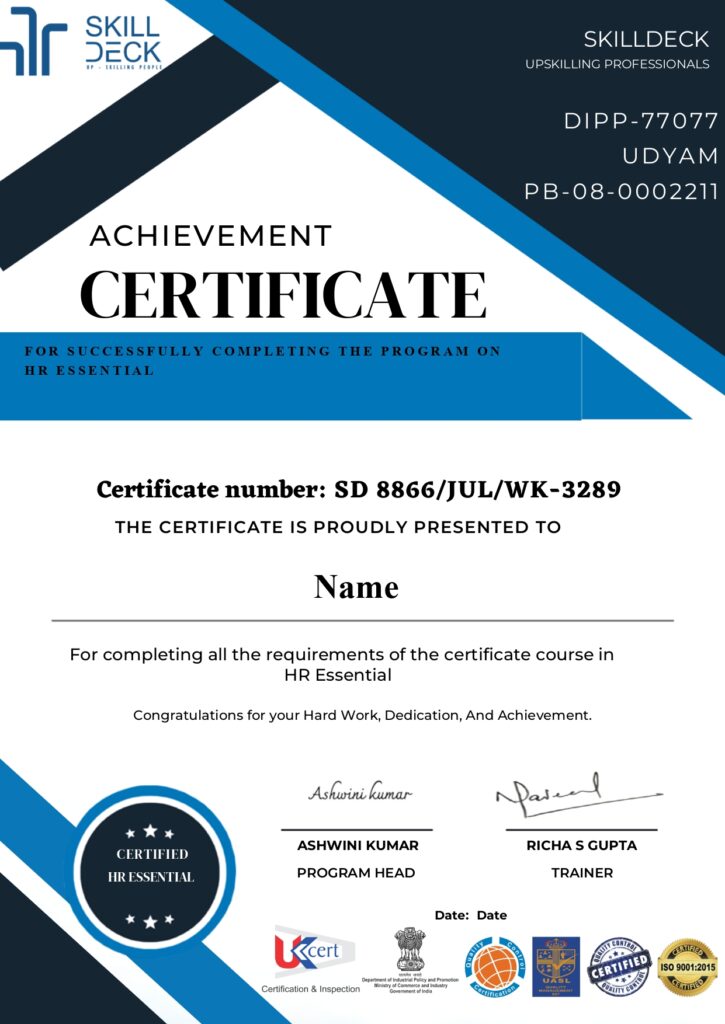

Trained
5,00,000
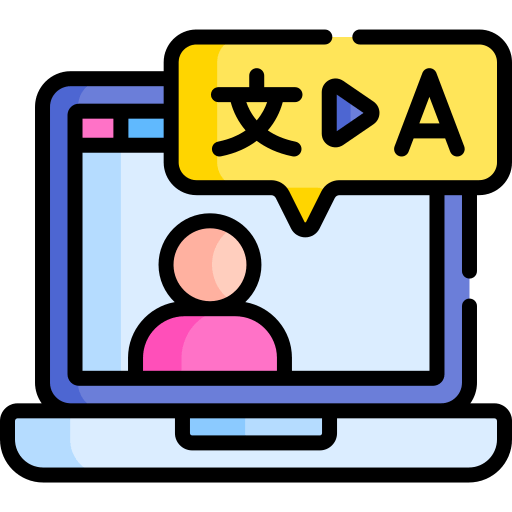
Live Classes/Month
500+
Google Reviews
1000+

Corporate Partners
50+

College Partner
90+
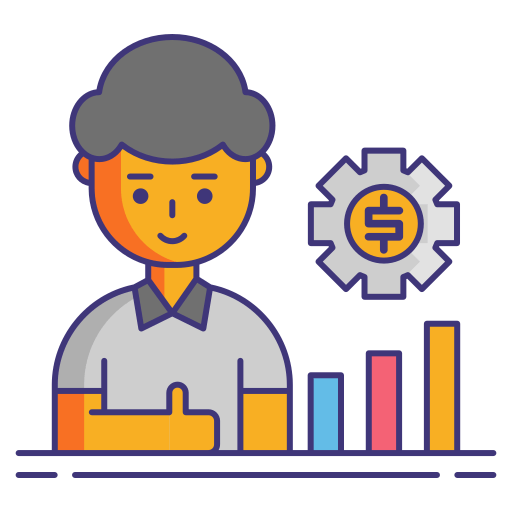
career benefits
91%
Pricing
₹6,500 ₹12999
- Certified & Experienced Instructors
- Flexible Schedule
- Masterclasses By Skill Deck®️
- Placement Assistance
- Access to the Recorded Sessions
- Live-Online Training
- Tailor Made Training
- 4 in 1 Program
- Globally recognised Platform

Meet Your Trainer
Richa Sareen
About the Trainer – Richa Sareen
Richa Sareen brings over 18 years of hands-on experience in Human Resources, having held strategic roles including HR Director and Head of Talent Acquisition across leading organizations. She is the Founder of SkillDeck, a premium HR consulting and training platform, where she has successfully trained and mentored over 5,000 HR professionals across India and abroad.
Richa’s programs are known for their practicality, industry relevance, and case study-based approach, covering everything from labor laws and HR audits to payroll, PMS, and strategic HR partnering. Her training is deeply rooted in real-time experience, making it easy for professionals to implement the learnings from day one.
🏆 Recognized Excellence:
SIWAA Award Winner – For outstanding contribution in HR training
IHRC Award – For Innovation in Human Resource Consulting
IEA Award – For Excellence in Employee Engagement & HR Solutions
🎥 She is also a well-known HR content creator on YouTube, simplifying complex HR topics like manpower planning, compliance, and Boolean search sourcing using real tools, templates, and examples. rephrase in small
HR Essentials/Operations Course Training Certification Process
Counseling & Registration
Consult one of the counselors to enroll in the right batch. Register yourself for the HR Essentials Course
Attend the Training in HR Essentials/Operations Course
Attend the Instructor-Led Sessions of the HR Essentials Course and get your Course Completion Certification. Go through the Recorded Sessions, in case you missed any topic or training
Submission of Projects Assigned
Submit the Hand-on Projects assigned during the training to the Trainers for Assessment and Certification
Earn Certification
Post Completion of the training, get Course Completion Certification of HR Essentials/Operations Course from The SkillDeck®
FAQs
Curriculum is specifically engineered to meet the expectations of leading tech companies.
This workshop also covers closing procedures, timelines to be followed, penalties for violation of legal provisions, and tips to write a detailed report about the incident.With the help of real-life cases, the participants will be guided through the topic from recognising sexual harassment to handling incidents appropriately, in the most efficient manner.
- HR & Administration Personnel Office & Factory
- Managers/Supervisors
- Anyone interested in strategic Hr planning with little background of human resources
The pedagogy is highly interactive, comprising case studies, interactive sessions, quizzes, assessments, class participation, presentations, project work, and class exercises imparted by SkillDeck faculty to help participants gain the knowledge, understanding, and hands-on skills to immediately apply their learning in the workplace.
Programme Fees: 5500 INR + 18% GST
Click here for certificate sample.
This is an online instructor led course where trainer will teach you over zoom
Yes skillDeck is a globally accredited firm with international accreditations and is also ISO, DIPP ,MSME registered under Indian laws so your certificate is globally accepted





